Avoid Skin Congestion with Scientifically Proven Methods
Can you imagine HD-perfect skin in your T-zone and cheeks?
If you look in the mirror and see large and visible pores now, this image seems like a dream that’s almost impossible to achieve.
Almost.
But this could be your reality through medically-proven pore-refining techniques.
Nothing will permanently clear and shrink your pores overnight. However, adopting a daily skincare routine that consistently removes and unclogs pores gradually will.
This involves having the right products suited for your skin, learning how to use them properly, and sticking to this regime faithfully.
This article will help you understand what causes large pores, what makes them clog, what you can do to unclog them, as well as preventive measures to avoid skin congestion.
Read on, and hopefully, by the end of this post, you’ll have found what you needed to keep your pores clear day in and day out.

Ask the Expert: Understanding Your Pores
BY SAMANTHA WELCH, ESTHETICIAN
Pore sizes differ depending on an individual's skin condition, age, hormones, and heredity.
However, in all circumstances, preventing build up of oil and dirt is crucial to minimizing the appearance of pores.
If you’re suffering from large or dilated pores, quick fixes like masks or blackhead extractions are a good start. However, these are temporary solutions to long-term skin issues.
Your large pores can also worsen as you age because your skin naturally loses its elasticity and ability to tighten pores.
There will come a time when none of these quick fixes will work, and a trip to your esthetician or dermatologist will be due.
Using a combination of treatments and multiple sessions can help improve the size and number of facial pores.
- When dealing with younger patients, we focus on controlling the production of oil in the skin.
- With older patients, in addition to controlling oil production, the focus should also be on rejuvenating the skin.
Doing so will prevent build up and make them appear smaller, resulting in a smoother and healthier complexion.
Until then, your goal should be to incorporate products in your daily and weekly skin regimen to prevent the causes of large facial pores and tighten the skin afterward.
What causes large pores?

Type 1
Pores are openings of a hair follicle where sweat and sebum collect. The most common cause of large pores is the accumulation of sebum and other impurities in these openings.[1]

When the pore is congested with excess oil, dead skin, and dirt, they clog the opening and make it appear larger.
This is mainly associated with oily and acne-prone skin with noticeable comedones like blackheads and whiteheads.
Dermatologist Recommendation: Help regulate oil production through regular exfoliation and mattifying or oil control products.[4]
E.g. NATURIUM BHA Liquid Exfoliant 2%, Kate Somerville ExfoliKate Intensive Exfoliating Treatment, ELEMIS Dynamic Resurfacing Facial Pads
Type 2
The other cause is the collapse or weakening of the pore walls due to the loss of skin elasticity.[2]
The results are sagging pores that the skin cannot tighten on its own.
This is associated with aging, acne scarring, hormonal imbalance, and sun damage.

This can be a common issue as the skin ages, as the natural loss of collagen and elastin can reduce skin elasticity and firmness. When the skin loses its elasticity, pores can become more visible and appear larger.
Additional factors that can exacerbate large pores are chronic acne, hormones, a poor skin regimen, and lifestyle choices (cigarettes, etc.).[3]
Note that there is no one-size-fits-all solution for pores that have lost their elasticity, and the best approach depends on individual factors, such as skin type and age, and diligent skincare.[5]
Dermatologist Recommendation: Boost skin elasticity through antioxidants, collagen synthesis, and other cell renewal actives like retinol.
E.g., SkinCeuticals C E Ferulic Serum, CeraVe Resurfacing Retinol Serum, Murad Anti-Aging Rapid Collagen Infusion for Face

Ask the Expert:
How to minimize the appearance of pores
BY SAMANTHA WELCH, ESTHETICIAN
Prevent excess oil, dead skin cells, and other impurities from blocking your pores regularly.
This applies to TYPE 1 and 2 causes and can be done by incorporating exfoliation into your skincare regimen.
There are two types of exfoliation: physical and chemical.
You can do one or both, depending on your skin type, age, and sensitivity.
If the cause is TYPE 1, an excess of sebum or oil, an additional step can be regulating or inhibiting oil production through mattifying or oil control products.[4]
If the cause is TYPE 2, enlarged pores are due to sagging or aging skin, boost skin elasticity through antioxidants, collagen synthesis, and other cell renewal actives.
Retinol is one of the most effective ingredients for changing how your gland produces oil. This can help address dilated and collapsed pores.
We’ve compiled the best products for unclogging and minimizing pores recommended by board-certified dermatologists to help you optimize your skincare regimen.
Choose products according to your skin type and needs.
Related: How to Stop Foundation Settling in Pores, A Makeup Artist's Foolproof Guide
How to Unclog Pores
In this section, we'll explore the most effective methods to keep your pores clear.
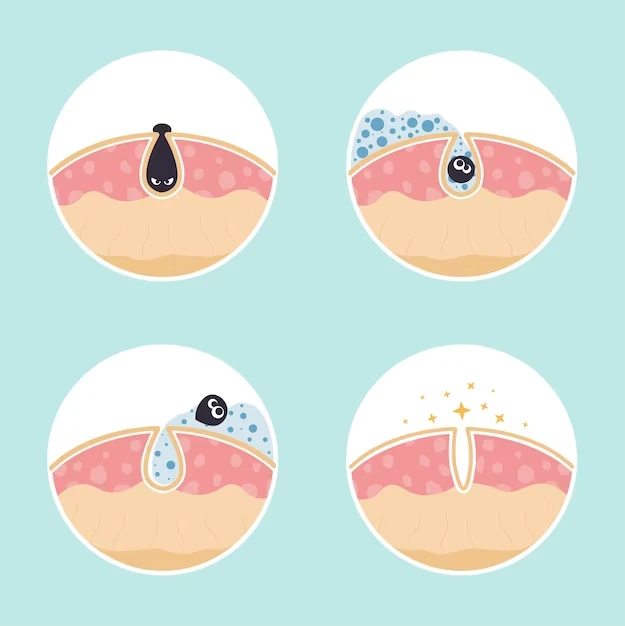
Unclog pores through regular exfoliation
One of the keys to minimizing pores is constantly removing the buildup of impurities on your skin and preventing them from reoccurring as much as possible.
Exfoliation should also be an essential part of your daily skincare routine if you have large pores, particularly if you have combination or oily skin.
Dead skin cells and excess oil collect at a rapid pace inside your pores, overloading them to capacity and making them look larger than they should be.
Cleaning them thoroughly daily prevents the accumulation of dirt, dead skin cells, sebum, and excess oil.[6]
This also reduces your chances of getting blackheads, whiteheads, and acne.
Blackheads are a key focus, not only in minimizing pores but also in acne prevention.
Blackheads occur in the first stage of acne. This blocked pore can become infected as it progresses, resulting in redness and more significant spots later on.
Prevention is key!
There are two types of exfoliation: mechanical or physical and chemical.
1.1 Mechanical or Physical Exfoliation
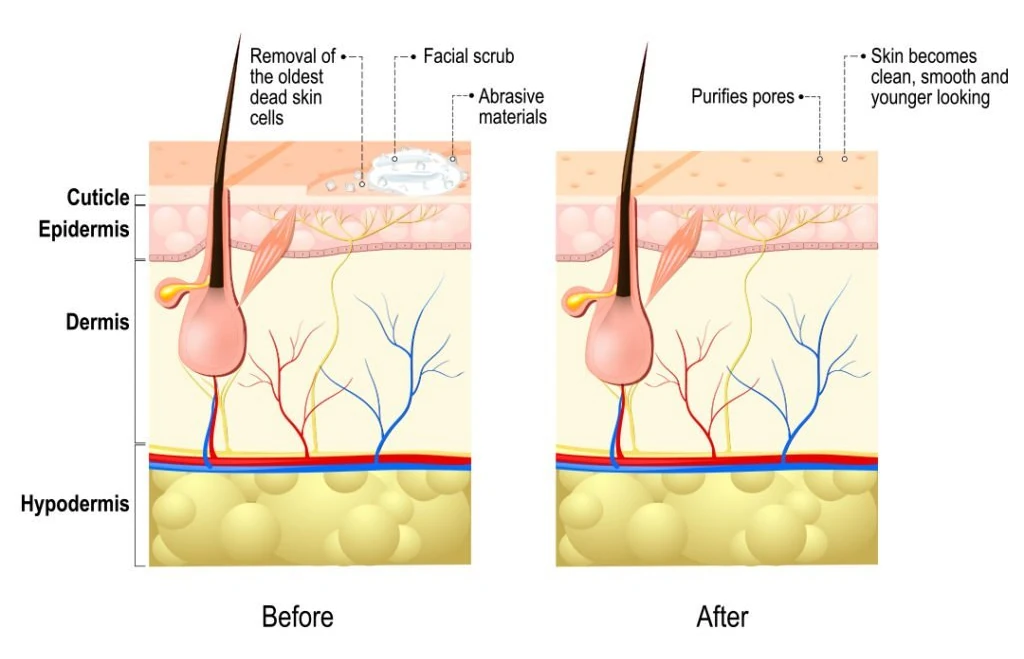
The Pros of Physical Exfoliation
Your skin produces sebum and dead skin cells, collecting dirt and oil daily. Physical exfoliation does a great job of ensuring that these impurities are removed thoroughly, especially those beyond the reach of your basic cleanser.
Physical or mechanical exfoliation involves using abrasive materials or tools to slough away dead skin cells and impurities on the skin's surface.
Here are some potential benefits of physical exfoliation:
- Immediate results – Physical exfoliation can provide quick results, making the skin look and feel smoother and softer after just one use.
- Accessibility and convenience – Physical exfoliants are widely available and can be found in various forms, such as facial scrubs, facial brushes, and microdermabrasion devices. They are also relatively easy to use and can be incorporated into any skincare routine.
- Customizable intensity – Physical exfoliation can be tailored to suit individual skin types and concerns, ranging from gentle, fine-grained scrubs to more intense exfoliants for thicker, oilier skin.
- Can be a great supplement to chemical exfoliation – Physical exfoliation can be an excellent addition to a chemical exfoliation routine, helping to maximize the benefits of both methods.
- Can help to unclog pores – Physical exfoliants can help to remove excess oil and impurities from the skin's surface, preventing clogged pores and reducing the appearance of blackheads and breakouts.
It's worth noting that, as with any skincare product, there are potential drawbacks to physical exfoliation, such as the risk of over-exfoliation, which can lead to irritation, sensitivity, and inflammation.
Using physical exfoliants in moderation and choosing products appropriate for your skin type and needs is essential.
Additionally, those with active acne or sensitive skin may want to avoid physical exfoliants altogether and opt for gentler chemical exfoliation methods instead.
The Cons of Physical Exfoliation
While physical exfoliation can provide immediate results and be convenient, there are also some potential cons to consider.
Here are some cons of physical exfoliation:
- Risk of over-exfoliation – Physical exfoliation can be harsh on the skin, and overusing or using too abrasive products can lead to irritation, inflammation, and damage to the skin's protective barrier.
- May not be suitable for all skin types – Physical exfoliants may be too abrasive for sensitive or delicate skin and may not be appropriate for those with active acne or other skin conditions.
- Can spread bacteria – Some physical exfoliants, such as loofahs or washcloths, can harbor bacteria if not cleaned and stored correctly, leading to breakouts and other skin issues. Daily resurfacing facial pads can be a convenient alternative.
- Potential for scarring – Overuse of harsh physical exfoliants can lead to scarring, especially if the skin is inflamed or irritated.
- Not effective for deeper exfoliation – Physical exfoliants only work on the skin's surface, so they may not be effective for more intensive exfoliation or for targeting deeper skin issues. That's where chemical exfoliation comes in. (see further down)
Not all physical exfoliants are the same; some may be gentler and more suitable for sensitive skin.
When choosing a product, make sure it is tailored to your skin type and needs, and use it sparingly to prevent over-exfoliation and any potential side effects.
Having a Healthy Skin Barrier is Important
The skin barrier is the outermost layer of the skin, which acts as protection to keep irritants out and moisture in. If your skin barrier is damaged, it can become more sensitive and reactive, leading to redness, inflammation, and dryness.
Physical exfoliants, such as scrubs or brushes, can be abrasive and may damage the skin if the barrier is compromised.
It's very important to maintain a healthy skin barrier before using exfoliants. This will ensure that the skin can tolerate the products and reap the benefits without causing irritation.
You can maintain a healthy skin barrier by:
- Using a gentle cleanser (E.g., CeraVe Hydrating Facial Cleanser, La Roche-Posay Toleriane Hydrating Gentle Face Cleanser with Niacinamide and Ceramides)
- Avoiding over-exfoliation
- Using hydrating and moisturizing products to keep the skin barrier healthy and intact (E.g. Bioderma – Sébium – Pore Refiner Cream, La Roche-Posay Effaclar Mat Oil-Free Mattifying Moisturizer).
Physical exfoliation can also spread the bacteria if you also have inflamed acne. So skip this step if you have active acne lesions.
This will also not be very effective on hard or plugged blackheads. Those kinds of clogged pores would need keratolytics like benzoyl peroxide to soften and release them.
We don't recommend pore strips because they can damage your skin when used regularly.
The goal is to reduce build-up to the point where you won't even consider using pore strips.
Ideal for combination and oily skin with visible blackheads and whiteheads. Not recommended if you have inflamed acne or sensitized skin (damaged skin barrier).
Related: The Best At Home Microdermabrasion Machines (With Video Reviews), The Best Face Washes & Cleansers for Oily Skin and Large Pores – Ultimate Guide & Review
1.2 Chemical Exfoliation
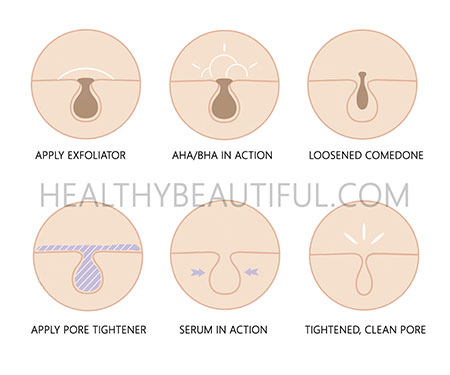
Chemical exfoliation uses AHA and BHA to gradually exfoliate the top layer of the skin.
AHA (alpha-hydroxy acid)
AHA is water-soluble and works to dissolve the upper layer of the skin to get rid of dead skin and dirt.
The most common AHAs in skincare are glycolic acid, lactic acid, and various fruit acids. It functions the same way as physical exfoliation without the devices.
Although there’s nothing like physically sloughing away impurities, this is a great alternative if you’re not keen on using mechanical scrubs.
A good in between are resurfacing facial pads. They are one of the gentlest forms of physical exfoliation, combined with the benefits of alpha-hydroxy or beta-hydroxy acids.
AHA also promotes cell turnover and renewal, which helps keep your complexion young and healthy. These types of products work well for all skin types.
Best for all skin types. When choosing the right product, you must be aware of your skin sensitivity. If you’re just starting to incorporate acids in your skincare routine, start from the lowest concentration and work your way up.
Related: Exceptional AHA Serums (Alpha Hydroxy Acid) for Clear & Radiant Skin, The Best Glycolic Acid Lotions & Creams for the Face & Body
BHA (beta-hydroxy acid)
BHA is oil-soluble, meaning unlike AHAs, it has the ability to go down into the skin to unclog blocked pores and flush out excess oil.
These are keratolytics, which means they loosen any firm plugs like whiteheads and blackheads and make the pore release its content.
This makes BHA-based products especially useful for oily and acne-prone skin to get rid of dirt and oil.
The Cons of Chemical Exfoliation
Chemical exfoliation can have several benefits, such as improving skin texture, reducing the appearance of fine lines and wrinkles, and helping to unclog pores. However, like any skincare treatment, there are also some potential drawbacks.
Here are some potential cons of chemical exfoliation:
- Irritation and sensitivity – Chemical exfoliants can be harsh on the skin, especially for sensitive skin. Overuse or incorrect use can lead to redness, dryness, and irritation.
- Sun sensitivity – Chemical exfoliation can increase skin sensitivity to the sun, so it's essential to wear sunscreen and limit sun exposure after using these products.
Related: The Best Sunscreens for Oily Skin (Dermatologist-tested), The Best Non-Comedogenic Sunscreens for Acne-Prone Skin - Risk of hyperpigmentation – If used too frequently or too aggressively, chemical exfoliants can increase the risk of hyperpigmentation, especially for those with darker skin tones.
Related: How to Get Rid of Hyperpigmentation - Allergic reactions – Some people may be allergic to certain ingredients in chemical exfoliants, such as alpha-hydroxy acids (AHAs) or beta-hydroxy acids (BHAs).
- Cost – Chemical exfoliants can be expensive compared to physical exfoliants or other skincare products, so they may only be affordable for some.
Not all chemical exfoliants are created equal, and different types and strengths of products can have different effects on the skin.
As with any skincare product, choose a chemical exfoliant that is appropriate for your skin type and needs and use it in moderation to avoid over-exfoliation and potential side effects.
Best for acne-prone, oily, and combination skin. We recommend using AHAs and BHAs in your skincare routine one after the other, with a 20-minute interval, if possible, for maximum absorption.
If you have oily and resilient, i.e., not sensitive skin with blackheads and whiteheads, we recommend doing both physical and chemical exfoliation.
A good in between are resurfacing facial pads. They are one of the gentlest forms of physical exfoliation, combined with the benefits of alpha-hydroxy or beta-hydroxy acids.
Related: The Best AHA + BHA Toners (Alpha & Beta Hydroxy Acid) for Different Skin Types, The Best Benzoyl Peroxide Moisturizers, Creams, Gels, and Lotions for Acne Spot Treatments
For an in-depth guide and to know which kind is better for you, refer to The Best At Home Chemical Peels – The Ultimate Guide.

Ask the Expert: How to Introduce AHAs & BHAs in your Routine
BY MICHELLE EVANS, ESTHETICIAN
When incorporating acids into your skincare routine, it's important to start slowly and use them in a way that works best for your skin.
Here are some general guidelines:
- Determine which acid(s) to use – Decide whether you want to use an AHA, BHA, or a combination of both.
AHAs are generally better for addressing concerns like dullness, fine lines, and hyperpigmentation, while BHAs are more effective for oily and acne-prone skin.
Consider your skin type and any specific skin concerns you have. - Consider a product type – AHAs and BHAs can be in all kinds of products, from cleansers, to toners, serums, peels, masks, and moisturizers. Evaluate your current routine and see where you can best incorporate your acid.
.- Rinse-off products – Acids in face washes, face masks, and scrubs are only on the skin for a short period. They are gentler but may not be as effective as leave-on products.
E.g. Murad AHA/BHA Exfoliating Facial Cleanser, innisfree Pore Clearing Clay Masks with Volcanic Cluster, SkinMedica AHA/BHA Exfoliating Cleanser - Leave-on products – Acids in toners, serums, or moisturizers penetrate deeper into the skin and provide more targeted and long-lasting benefits. They can help to improve skin texture, reduce the appearance of fine lines and wrinkles, and address specific skin concerns like hyperpigmentation and acne. However, they can also be more potent and have a higher risk of irritation or sensitivity.
E.g. REN Clean Skincare – AHA Facial Toner, NassifMD Detox Pads Facial Radiance Pads, Mario Badescu A.H.A. & Ceramide Face Moisturizer
- Rinse-off products – Acids in face washes, face masks, and scrubs are only on the skin for a short period. They are gentler but may not be as effective as leave-on products.
- Consider the frequency of use. – You can choose between a weekly, biweekly, or daily application. This is related to the type of product you choose.
.- Weekly Exfoliation – If you already have a daily skincare routine that works for you, you can add regular bi-weekly peels to your regimen. These are separate peeling sessions where you unclog build-up throughout the week. These come in peels or masks.
E.g. Sonage Harmony Glycopolymer Solution | Glycolic Acid Facial Exfoliator, Juice Beauty Green Apple Peel Full Strength Exfoliating Mask
- Daily Exfoliation – You can find a product with AHA/BHA to add or replace in your daily skincare.
E.g. Murad Daily Clarifying Peel – Exfoliating Peel Solution – Resurfacing Retinoid, EXUVIANCE Daily Resurfacing Peel CA10 One-step Leave-on Face Peel with Citric Acid, Dr. Dennis Gross Alpha Beta Universal Daily Peel
- Weekly Exfoliation – If you already have a daily skincare routine that works for you, you can add regular bi-weekly peels to your regimen. These are separate peeling sessions where you unclog build-up throughout the week. These come in peels or masks.
- Start with a low concentration – If you're new to using AHAs or BHAs, start with a low-concentration product (e.g., 5-10%) and gradually work your way up. This will help your skin adjust and minimize the risk of irritation.
Related: The Best At Home Chemical Peels – The Ultimate Guide - Listen to your skin – Pay attention to how your skin responds to the product.
Some patients have such resilient skin that they can take multiple acids in a routine. Some have skin so sensitive that they can't use any exfoliants at all.
If you experience any irritation or sensitivity, reduce the frequency of use or switch to a lower-concentration product. - Use them at the right time – AHAs and BHAs can make your skin more sensitive to sunlight, so it's best to use them at night. If used during by day, use sunscreen with at least SPF 30.
Related: The Best Sunscreens for Oily Skin (Dermatologist-tested), The Best Non-Comedogenic Sunscreens for Acne-Prone Skin
Use a clay-based or charcoal-based masks to instantly unclog pores
One of the easiest and quickest ways to decompress the pore is to draw the impurities out naturally.
Clay-based masks are like magnets that absorb deep-seated oils and contract the skin as it dries out.
Use them once or twice a week to dislodge deep-seated oils. Make sure to moisturize well right after to avoid dehydrating your skin.
We recommend this over pore strips which can damage your skin.
E.g. Mario Badescu Collagen & Clay Mask, Caudalie Instant Detox Clay Mask, Clarins SOS Pure Rebalancing Clay Mask, boscia Luminizing Charcoal Mask – Vegan Peel off Face Mask
Manual extraction for deep-seated sebum & tough comedones
Honestly, once you’ve incorporated regular exfoliation in your regime, you would hardly need to do manual extractions.
However, there are instances when it does call for it, like deeply seated sebum, tough blackheads, bad skin days, or if you have excessively oily skin because of hormonal imbalance, etc.
E.g. Blackhead Remover Vacuum & Tool with Camera, Spa Sciences MIO Diamond Microdermabrasion Blackhead Remover, VBoo Extraction Tools
Control your skin’s oil production during the day
Excessive sebum secretion is one of the leading factors in dilated pores. If you have an overproduction of oil, this can mix with dead skin cells and other debris, clogging the pores and forming black and whiteheads. This can cause your pores to appear larger and more noticeable.
Inhibiting oil production throughout the day is the first step in preventing clogged pores.
Oil control products
Purifying cleansers are important for minimizing large pores because they can help remove dirt, excess oil, and dead skin cells from the skin, which can clog the pores and make them appear larger.
E.g. La Roche-Posay Toleriane Purifying Foaming Facial Cleanser, boscia Detoxifying Black Charcoal Cleanser
You can incorporate your AHAs and BHAs in your cleanser as well if you want a simnpler routine. Note that the acid only keeps in contact with your skin for short period. It's a gentler approach but may not be as effective as leave-on AHA/BHA serums or toners.
E.g. Murad Clarifying Facial Cleanser – Acne Control Salicylic Acid & Green Tea Extract Face Wash, La Roche-Posay Effaclar Medicated Gel Facial Cleanser
Hydrate your skin + Oil-absorbing products
If your skin is overly dry, it compensates for its lack of moisture with an excess production of oil. Ensuring your skin is well-hydrated is essential to keeping you shine-free and your pores healthy and tight.
Mattifying moisturizers and primers can contain ingredients that help to absorb excess oil, leaving the skin with a matte finish and a more refined appearance. Look for products that are made with ingredients like silica or kaolin clay.
Once the mattifying effect kicks in, it will not only control oil but also diffuse the light that hits your skin. This will make your pores appear smoother to the naked eye. A win-win!
PSA: Always use non-comedogenic skincare and cosmetics formulated for acne-prone skin.
E.g. Murad Oil & Pore Reducing Facial Moisturizer, Caudalie Vinopure Oil Control, Hydrating & Mattifying Moisturizer, Bioderma – Sébium – Pore Refiner Cream, DOCTOR BABOR Refine RX Pore Refiner
Using a combination of oil-control and oil-absorbing products can help to keep your pores clear and maintain them over time. Choose products suitable for your skin type to avoid over-drying the skin, which can also lead to the overproduction of oil.
Related:
- How to Control Oily Skin: Fool-Proof Steps
- The Best Non-Comedogenic Moisturizers for Acne-Prone Skin
- The Best Non-Comedogenic Matte Primers for Oily Skin
- The Best Non-Comedogenic Primers for Acne-Prone Skin
- The Best Non-Comedogenic Drugstore Primers
- jane iredale – Smooth Affair® Mattifying Face Primer Review
Use sunscreen in the day to prevent UV damage
Sunscreen is vital for preventing large pores because exposure to UV rays can damage the skin and lead to a loss of collagen and elastin. This can cause your skin to lose its elasticity and firmness. When skin loses its elasticity, pores can become more visible and appear more prominent.
Additionally, exposure to UV rays can cause hyperpigmentation and other forms of skin damage, which can contribute to the appearance of large pores. Using a broad-spectrum sunscreen daily can help protect your skin from UV damage and reduce the risk of collagen and elastin breakdown, which can help prevent the formation of large pores over time.
Furthermore, sun damage can also cause oil overproduction, which can clog pores and form black and whiteheads. Using sunscreen can help prevent excess oil production and reduce the risk of clogged pores, which can also contribute to the appearance of large pores.
E.g. Tatcha Silken Pore Perfecting Sunscreen SPF 35, La Roche-Posay Anthelios Anti-Aging Primer with Sunscreen, 50 SPF, DERMALOGY by NEOGENLAB UVA/UVB SPF50 Day-Light Protection Airy Sunscreen
Nourish your skin at night to tighten your pores
Incorporating retinol and collagen into your nighttime skincare routine is crucial for minimizing large pores because they can help improve skin texture and increase skin elasticity.
Retinol, a form of Vitamin A, is a potent antioxidant that can help stimulate collagen production, reduce the appearance of fine lines and wrinkles, and improve overall skin texture. It also significantly changes how your skin produces oil. Not only does this key ingredient tackle blackheads, pores, and acne, but it is also at the forefront of anti-aging.
Collagen, on the other hand, is a protein that provides structure and elasticity to the skin. As we age, our collagen levels decrease, leading to skin laxity and the appearance of larger pores. Once your skin has lost its firmness, your pores will sag and enlarge. Increasing collagen production can prevent this and help reduce the appearance of large pores over time.
If you start using these in your 20s, you can slow down your skin’s aging and keep your pores refined well into your 30s and 40s.
Applying these ingredients when sleeping is particularly effective because the skin is most receptive to repair and renewal processes.
E.g. Advanced Organic Retinol Pore Refining Night Cream, Sunday Riley A+ High-Dose Anti Aging Retinol Serum, Ebanel 2.5% Retinol Cream
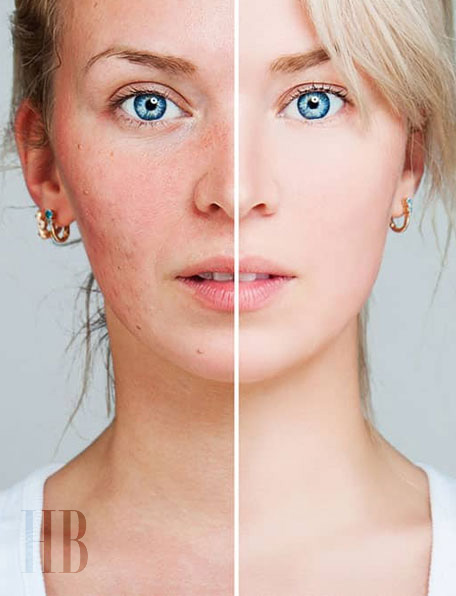
Recommended Acne Programs
If you're suffering from severe acne, it's best to undergo a program that will help you get to the root of the problem and address the causes.
- The Acne No More System by Mike Walden – Restores hormonal balance to achieve permanent clear skin for life.
- The “Trifecta Glow” System – A highly potent brightening treatment guaranteed to reduce the appearance of dark spots & acne scars within 4 weeks.
- La Roche-Posay – Effaclar Dermatological 3 Step Acne Treatment System
- Murad – Acne Control Kit – Breakout Skin Care Kit
- Mario Badescu – Acne Starter/Control/Repair Kit
- Dermalogica – Clear Start Breakout Clearing Kit
References:
- Roh, M., Han, M., Kim, D. and Chung, K. (2006), Sebum output as a factor contributing to the size of facial pores. British Journal of Dermatology, 155: 890-894. https://doi.org/10.1111/j.1365-2133.2006.07465.x
- Kim, B., Choi, J., Park, K. and Youn, S. (2013), Sebum, acne, skin elasticity, and gender difference – which is the major influencing factor for facial pores?. Skin Res Technol, 19: e45-e53. https://doi.org/10.1111/j.1600-0846.2011.00605.x
- Lee, Sang Ju MD, PhD; Seok, Joon MD; Jeong, Se Yeong MD; Park, Kui Young MD, PhD; Li, Kapsok MD, PhD; Seo, Seong Jun MD, PhD Facial Pores, Dermatologic Surgery: March 2016 – Volume 42 – Issue 3 – p 277-285 doi: 10.1097/DSS.0000000000000657
- Katsuta, Yoshio, Takao Lida, S. Inomata and Satoshi Yoshida. “Improving the appearance of facial pores.” Cosmetics and toiletries 119 (2004): 59-64.
- Uhoda, E., Piérard-Franchimont, C., Petit, L. and Piérard, G. (2005). The Conundrum of Skin Pores in Dermocosmetology. Dermatology, 210(1), pp.3-
- Kwon, K. C., Lee, S. W., Kim, H., Jeon, H., & Park, S. W. (2021). Reduction of enlarged facial pore using ion‐paired amino acid through enhancement in skin permeation and exfoliation: A placebo‐controlled in vivo study. Journal of cosmetic dermatology, 20(1), 274-284.

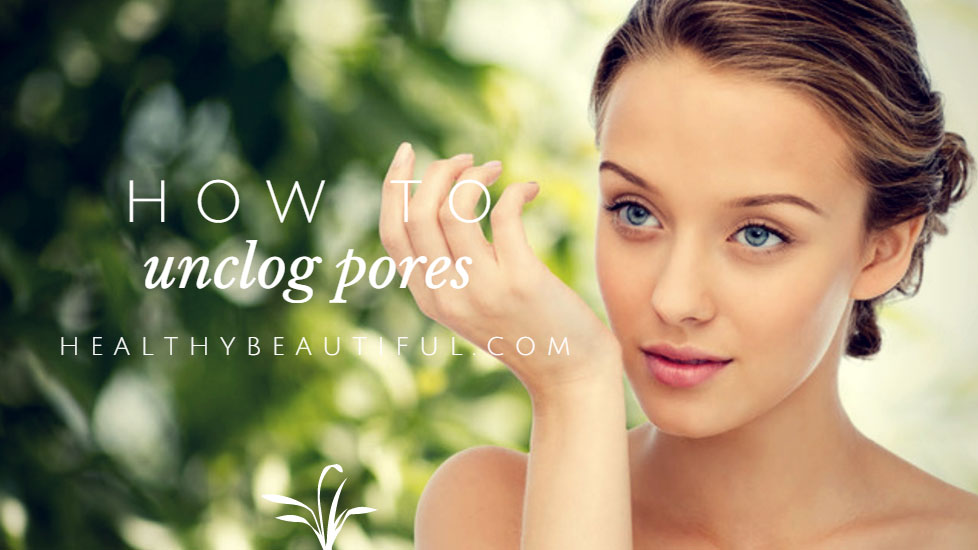
This is a fantastic article….VERY helpful!!!
This is by far the most helpful article I have read to understand my skin and what to do about it. Thank you!